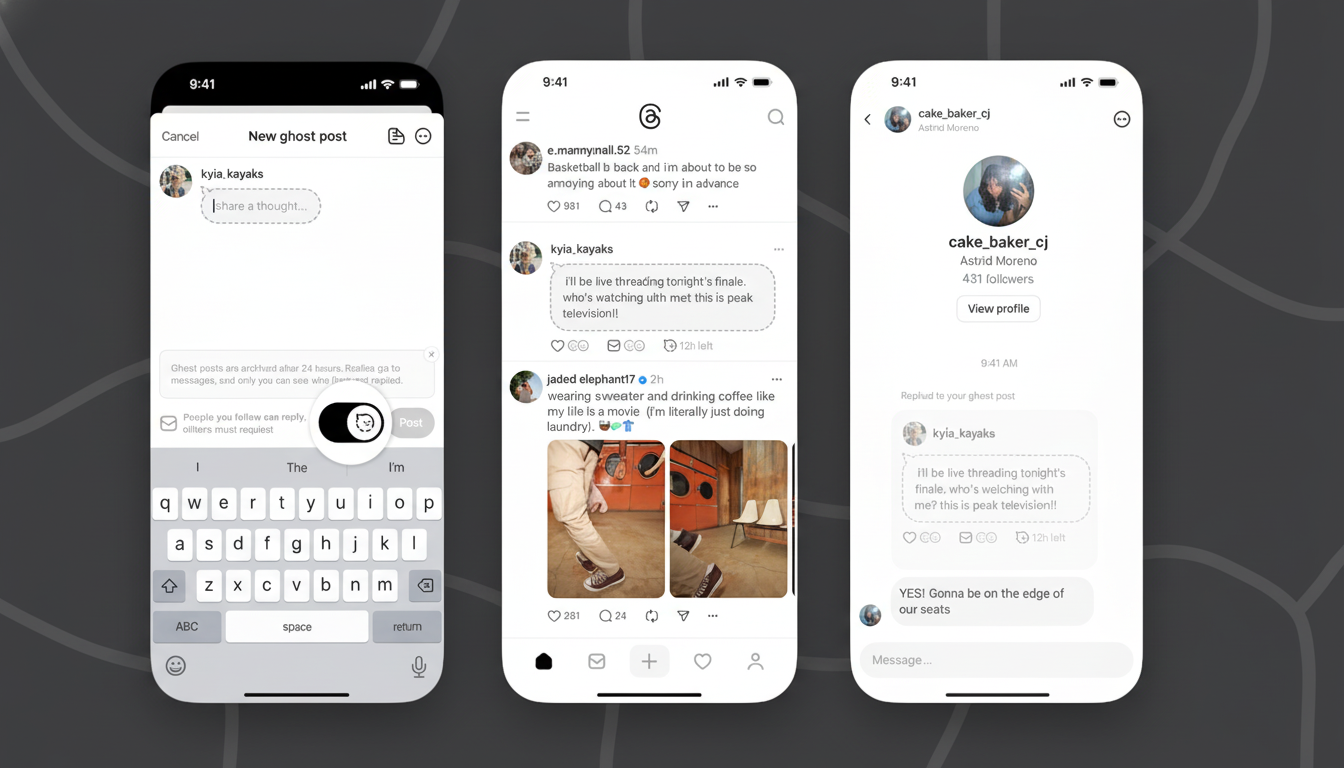Threads is ramping up a new way to talk openly before content disappears forever with “ghost posts,” similar to Snapchat, where form can be free and slow if one needs it to.
The feature is meant to elevate casual, in-the-moment conversation while dialing down the pressure of posts living permanently on a person’s Facebook page.
- How Ghost Posts Work on Threads and What You See
- Why Ephemeral Text Matters for Conversations on Threads
- How Threads Competes With X by Taking a Different Angle
- Implications for Safety, Privacy, and Moderation on Threads
- What Creators and Brands Can Do With Ghost Posts
- Open Questions About Ghost Posts and What Comes Next

The move is a significant expansion of Threads’ toolkit as it vies for attention in the text-first social space. With over 400 million monthly users, the platform is betting that ephemerality — and a feature that funnels replies into private messages — will reform how people share and interact.
How Ghost Posts Work on Threads and What You See
Making a ghost post is easy: hit the new ghost button in the compose screen on mobile and publish as usual. In feeds, the post will look like an ephemeral post in a dotted conversation bubble that distinguishes it from normal content.
Responses are open to anyone on mobile or desktop, but they bypass the public thread and go straight to the original poster’s DMs. So the back-and-forth takes place in private — reducing the space for pile-ons to play out in the open, while still allowing interaction.
Engagement signals are intentionally lightweight. Viewers can tell that a ghost post has activity in its bubble with smiley-faced icons, but only the author can see precise totals and who contributed. After 24 hours, the post vanishes from public timelines; creators can retrieve it in Archive under Settings.
Why Ephemeral Text Matters for Conversations on Threads
Visual forms of sharing ephemerally are already commonplace. Snapchat helped make vanishing messages mainstream, and Instagram Stories — daily fodder for hundreds of millions — showed that brief content reduces the stakes but increases spontaneity. It has not been as easy for text networks to pull off a similar coup: Twitter’s Fleets, debuted in 2020, was taken down with little fanfare after few people used it.
Ghost posts import the “say it now, don’t overthink it” dynamic to text. By defaulting DM replies and keeping metrics semi-private, Threads is intentionally minimizing the social scoreboard effect that can discourage everyday sharing. Scholars of communication have long speculated that ephemerality could be a way to relieve context collapse — when one permanent post is expected to appeal simultaneously to friends, colleagues, and strangers.
How Threads Competes With X by Taking a Different Angle
With X, people who want a pristine timeline lean on third-party tools — often paid ones — to bulk delete old shares. Threads is cooking up a more graceful solution: share as much and as often as you like, have the media expire automatically, but maintain a private archive for later reference. It’s a modest but potent differentiator that aligns with the platform’s broader shift toward healthier conversation.

The new feature comes as Threads continues to roll out updates, such as:
- Custom feeds
- Direct messages
- Fediverse sharing via ActivityPub (a protocol for federated social media)
- Longer text posts up to 10,000 characters
- Spoiler tags
- Interest-based communities
Ghost posts add one more reason to post in real time without fretting about long-tail repercussions.
Implications for Safety, Privacy, and Moderation on Threads
Though dogpiles and brigading flourish in public replies, moving quote tweets into DMs could tamp them down. At the same time, it nudges more of that conversation into private channels where safety systems must continue to be vigilant. Threads says its community guidelines and reporting tools apply both to public and private surfaces, but the tension between intimacy and safety will be a key thing to watch.
Your engagement will also be less visible, possibly cutting down on performative posting sparked by likes. And for many, that can reduce anxiety. And for bad actors, it eliminates a public metric to game. “These choices are consistent with our broader industry shift toward privacy-focused signals and more robust feedback loops.”
What Creators and Brands Can Do With Ghost Posts
Ghost posts unlock tactical use cases while preventing timeline clogging. And yes, creators can run quick flash Q&As or live-comment sports or awards shows, not to mention share behind-the-scenes notes that don’t require a permanent slot. Brands could experiment with limited-time offers, quick polls, or real-time customer support prompts before pushing conversations into DMs to sort out.
Given that authors keep their own private archive, they could “audit” old ghost posts and check out audience reactions, then surface ideas in longer, better-groomed threads later if they stick. That virtuous cycle is good for experiments without going soft on editing.
Open Questions About Ghost Posts and What Comes Next
There are still details to watch: how ghost posts will show up in search or recommendations while active, how they work with third-party clients or ActivityPub federation, and whether analytics for creators will expand beyond mere private engagement counts. Clear guidance here will be important for professional users who make decisions based around performance data.
In the meantime, ghost posts afford Threads a unique, low-pressure format that matches how people are already communicating elsewhere. If it succeeds, the feature could reset the pace and tone of conversation on the platform — and set a new bar for competitors to match. Purely social posts still rely on great content or relationships between individuals in order to spread.

